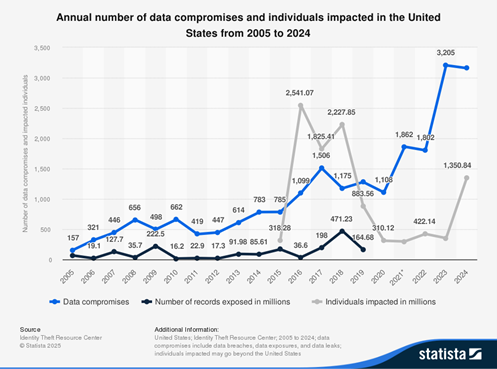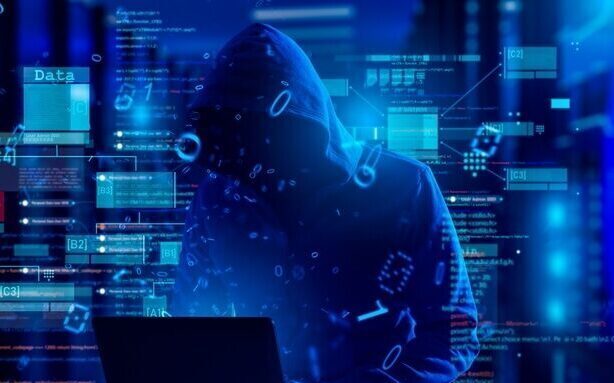At the onset of both World War I and World War II, America was insulated from the battles taking place thousands of miles away in Europe and Asia.
However, the art of conflict has changed dramatically since then.
Battles aren’t just fought by land, air and sea. They are also fought in the digital world.
While rockets and drones fly overhead in Ukraine and Israel, other battles are being fought online, as bad actors working on behalf of dangerous regimes to cripple defense systems and supply chains.
Rather than external destruction and loss of life, these digital wars cost trillions and can severely impact what’s happening on the battlefield.
And that’s where cybersecurity comes in…
Cybercrime’s Race to $10.5 Trillion
The Identity Theft Resource Center found that more than 3,000 separate data compromises occurred in 2024, impacting more than 1.3 million Americans.

It was the second-highest number of breaches and the fourth-biggest impact on individual Americans in the last 10 years.
Separately, Microsoft estimates there are nearly 600 million cyberattacks globally every day. These range from a simple website hack to compromise and collect data, to hacking another nation’s security infrastructure to cause disruption.
What’s even more staggering is the cost. Cybersecurity Ventures estimates global cybercrime damage costs to reach $10.5 trillion this year.
Just last month, the Center for Strategic & International Studies found five separate incidents of one nation cyberattacking another:
- The Czech Republic’s Foreign Ministry was attacked. The breach was attributed to China.
- Russian hackers conducted an espionage campaign against educational, government and research-related entities in Tajikistan.
- Kurdish military forces operating in Iraq were targeted with a bug to intercept military messages by a Turkish espionage group.
- China targeted British government departments and critical infrastructure, including members of Parliament and the Electoral Commission.
- The United States, Britain, France, Germany and other allies issued an advisory warning about a Russian cyber campaign targeting the delivery of defense support to Ukraine and other NATO defense and tech sectors.
More glaring, Russian cyberattacks on Ukraine jumped 70% in 2024, targeting government services, the energy sector and defense-related entities.
Chinese cyberattacks on Taiwan doubled to 2.4 million daily attempts in 2024.
These attacks, while claiming no lives, also know no borders and wreak havoc on those targeted.
Of course, these bad actors have to overcome cybersecurity first. The companies providing those critical digital services are enjoying rapid growth in the market.
Cybersecurity Stocks Outpacing Benchmark
Now that we see the growing impact of cyberattacks, no matter the size, scope or target, we can look at this from an investment perspective.
Given the current global climate, you might be looking at cybersecurity stocks as a potential for your portfolio.
For this purpose, I examined the Amplify Cybersecurity ETF (HACK), which invests in companies within the cybersecurity industry and tracks the performance of the ISE Cyber Security Select Index.
Because of the rise in cyberattacks globally, cybersecurity stocks have grown rapidly over the last 12 months.
HACK Jumps 34% Since June 2024

HACK (the blue line in the chart above) has increased more than 34% in the last 12 months, while the S&P 500 (yellow line) has only gained 10.6%.
This means cybersecurity stocks have outpaced the benchmark by a 3-to-1 margin.
The final step in the analysis is to perform an “X-ray” on stocks held by HACK. I run each stock through Adam’s Green Zone Power Rating system to find the average rating for the ETF.
The result was somewhat surprising.
HACK ETF Rates “Neutral”

The ETF scores a “Neutral” 42 out of 100 on Adam’s system. This is primarily driven by lower Size (average of 24) and Value (average of 18) ratings.
Nine of the 21 rated stocks in the HACK ETF rate “Strong Bullish” on Momentum, while 10 are “Strong Bullish” on Quality, and seven are “Strong Bullish” on Growth.
It’s important to note that only three stocks in the ETF are “Strong Bullish” overall, and eight stocks are rated below 30, meaning they are bearish and should underperform.
The cybersecurity industry is undoubtedly on the rise with the increase in global threats and geopolitical instability.
However, HACK’s neutral rating on Adam’s Green Zone Power Rating system tells me this isn’t quite the time to pick the HACK ETF for your portfolio.
That’s all from me today.
Safe trading,

Matt Clark, CMSA®
Chief Research Analyst, Money & Markets





